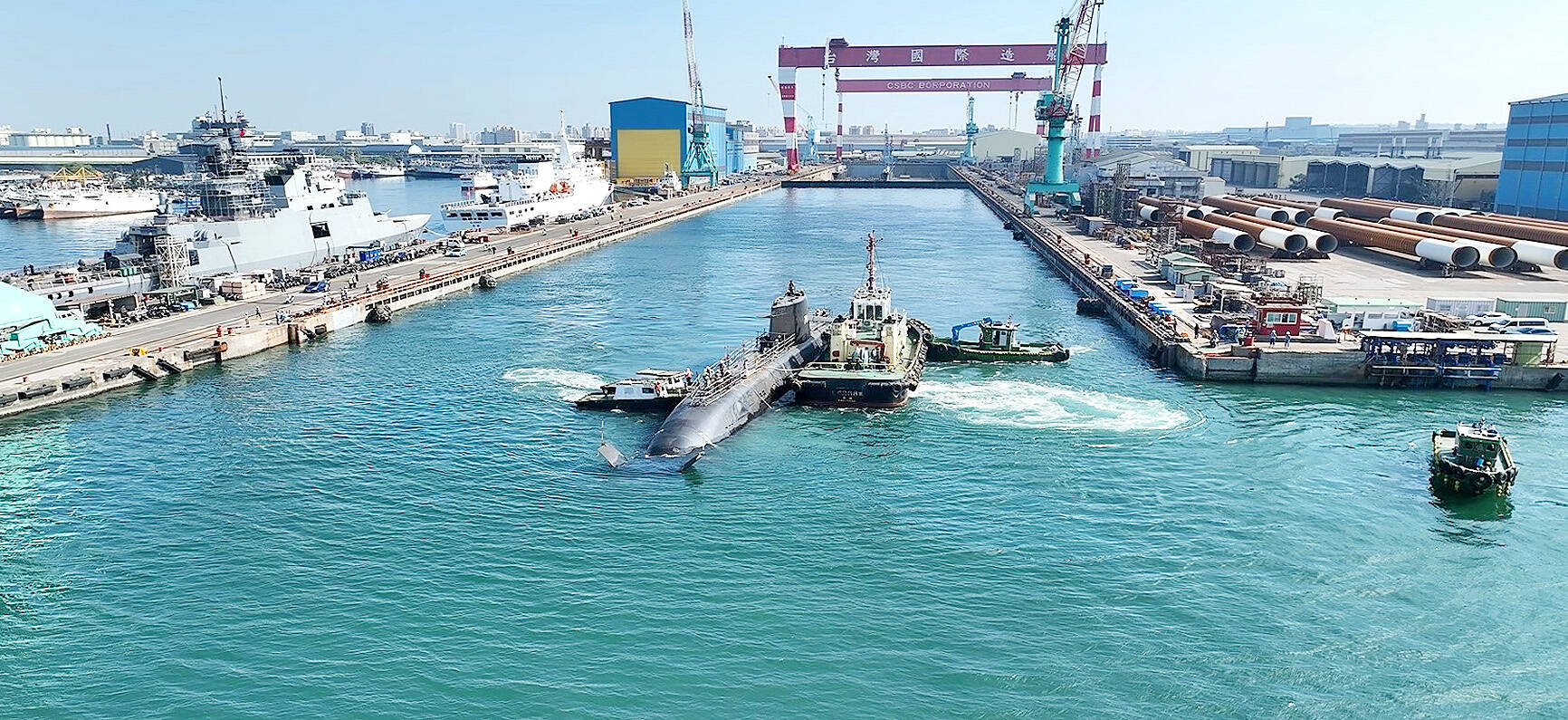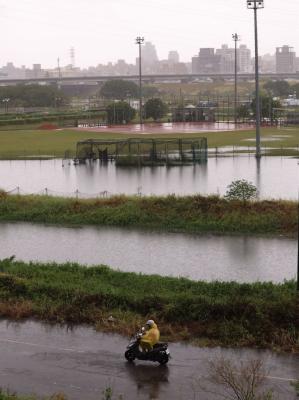The prototype of the Hai Kun-class indigenous defense submarine was moved from a dry dock to another dock in Kaohsiung yesterday to facilitate more testing.
A photograph of the vessel being towed was posted on Facebook by hobbyist group Vessel Story (船舶物語) hours before CSBC confirmed it in a news release.
The Hai Kun-class submarine was moved to Dock No. 91 of the Port of Kaohsiung to facilitate tuning its diesel-electric power plant and conduct a harbor acceptance trial following the completion of pre-submergence and incline tests, the shipbuilder said.

Photo courtesy of CSBC
CSBC has confidence that the vessel would comply with all safety standards, performance requirements and project timetables, including its planned sea trial in April, the company said.
The Hai Kun program of attack submarines has become symbolic of Taiwan’s efforts to build asymmetric capabilities to counter China’s superior numbers and firepower should the two come to blows.
Last month, lawmakers from the Chinese Nationalist Party (KMT) and the Taiwan People’s Party froze half of the annual funding for work on the planned submarine fleet as part of massive cuts to the central government’s general budget.
The Ministry of National Defense’s ability to access the suspended funds is contingent on the timely completion of the prototype’s sea-acceptance trial, putting the testing under intense scrutiny.
Unstable voltage in the vessel’s electrical systems had burned out components at an unsustainable rate, Chinese-language online news provider Up Media reported on Sunday, citing an anonymous source.
The need to replenish spare parts is likely to push back the delivery date, it said.
Democratic Progressive Party Legislator Chen Kuan-ting (陳冠廷) — who is a member of the Foreign Affairs and National Defense Committee — disputed the report, saying that replacing or changing specifications of components is routine in the testing phase.
The navy considers the performance of the submarine to be up to specifications and nothing important had gone amiss with its construction, Chen said, citing conversations with senior navy officers.
The allegations regarding parts being burned out by unstable voltage were incorrect, as the submarine had ready access to shore-based, voltage-regulated power sources if onboard systems proved unreliable, he said.
The navy fully expects to initiate sea trials on time, Chen said, adding that the public should support the ministry’s program to manufacture submarines domestically.

Taipei, New Taipei City, Keelung and Taoyuan would issue a decision at 8pm on whether to cancel work and school tomorrow due to forecasted heavy rain, Keelung Mayor Hsieh Kuo-liang (謝國樑) said today. Hsieh told reporters that absent some pressing reason, the four northern cities would announce the decision jointly at 8pm. Keelung is expected to receive between 300mm and 490mm of rain in the period from 2pm today through 2pm tomorrow, Central Weather Administration data showed. Keelung City Government regulations stipulate that school and work can be canceled if rain totals in mountainous or low-elevation areas are forecast to exceed 350mm in

EVA Airways president Sun Chia-ming (孫嘉明) and other senior executives yesterday bowed in apology over the death of a flight attendant, saying the company has begun improving its health-reporting, review and work coordination mechanisms. “We promise to handle this matter with the utmost responsibility to ensure safer and healthier working conditions for all EVA Air employees,” Sun said. The flight attendant, a woman surnamed Sun (孫), died on Friday last week of undisclosed causes shortly after returning from a work assignment in Milan, Italy, the airline said. Chinese-language media reported that the woman fell ill working on a Taipei-to-Milan flight on Sept. 22

COUNTERMEASURE: Taiwan was to implement controls for 47 tech products bound for South Africa after the latter downgraded and renamed Taipei’s ‘de facto’ offices The Ministry of Foreign Affairs is still reviewing a new agreement proposed by the South African government last month to regulate the status of reciprocal representative offices, Minister of Foreign Affairs Lin Chia-lung (林佳龍) said yesterday. Asked about the latest developments in a year-long controversy over Taiwan’s de facto representative office in South Africa, Lin during a legislative session said that the ministry was consulting with legal experts on the proposed new agreement. While the new proposal offers Taiwan greater flexibility, the ministry does not find it acceptable, Lin said without elaborating. The ministry is still open to resuming retaliatory measures against South

1.4nm WAFERS: While TSMC is gearing up to expand its overseas production, it would also continue to invest in Taiwan, company chairman and CEO C.C. Wei said Taiwan Semiconductor Manufacturing Co (TSMC) has applied for permission to construct a new plant in the Central Taiwan Science Park (中部科學園區), which it would use for the production of new high-speed wafers, the National Science and Technology Council said yesterday. The council, which supervises three major science parks in Taiwan, confirmed that the Central Taiwan Science Park Bureau had received an application on Friday from TSMC, the world’s largest contract chipmaker, to commence work on the new A14 fab. A14 technology, a 1.4 nanometer (nm) process, is designed to drive artificial intelligence transformation by enabling faster computing and greater power